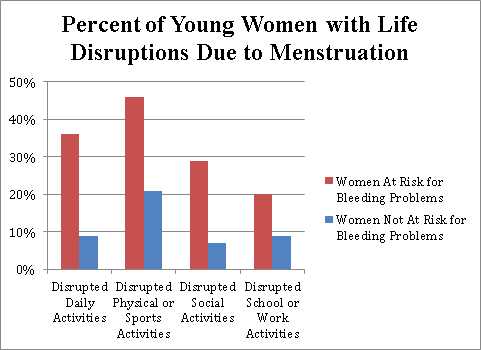Survey Findings on Young Women and Bleeding Disorders

Information about bleeding disorders is vital for young women. It can help them recognize symptoms sooner and prompt them to seek medical care faster so that they get an earlier diagnosis and treatment. To help ensure that health education materials are adopted and used, they must be designed to meet the needs of the intended users. Therefore, the Division of Blood Disorders in the National Center on Birth Defects and Developmental Disabilities (NCBDDD) at the Centers for Disease Control and Prevention (CDC) along with the National Hemophilia Foundation (NHF) and Harris Interactive worked together to develop and carry out a national internet survey of young women that aimed to:
- Learn more about young women’s thoughts about menstruation or menstrual periods (normal vaginal bleeding that occurs as part of a woman's monthly cycle) and heavy bleeding.
- Find out how much young women know about bleeding disorders in general and whether or not they are familiar with the signs and symptoms of a bleeding disorder.
- Determine the types of messages that are the most influential in getting young women to seek care from their health-care provider.
A total of 1,243 young women aged 18 to 25 participated in the survey. This article was published by the American Journal of Preventive Medicine and you can read the summary here.
How do Bleeding Disorders Affect Women?
Bleeding disorders are a group of conditions that occur when the blood cannot clot properly. The most common bleeding disorder in women is von Willebrand disease (VWD), which occurs in about 1%, or approximately 1.6 million women in the United States. Women with VWD may experience symptoms such as nosebleeds, easy bruising, and heavy menstrual periods that last longer than a week. This heavy menstrual bleeding is also known as menorrhagia.
Another bleeding disorder is hemophilia. Hemophilia is a rare disorder caused by a mutation or change in a gene. Hemophilia runs in families, but typically affects only boys or men. Women generally do not have hemophilia but they can pass on the mutation for hemophilia to their children. Some women with the hemophilia mutation may have mild bleeding symptoms such as heavy bleeding during periods or problems with bleeding during childbirth. At the time of childbirth, women with bleeding disorders are more likely to experience excessive blood loss called postpartum hemorrhage.
Women with a family history of bleeding disorders should talk with their doctor to learn their risks. Blood tests are generally done by a hematologist (a doctor who specializes in blood diseases) to find out whether a woman has a bleeding disorder.
Main findings from this survey:
- About 1 in 100 U.S. women may have an undiagnosed bleeding disorder, which can reduce quality of life and lead to life-threatening health problems during menstruation, childbirth, and surgery.
- A majority of young women knew that a bleeding disorder is a condition in which bleeding takes a long time to stop (77%) or blood does not clot (66%).
- Women at risk for bleeding problems were defined as either having periods lasting 8 days or longer, often or always bleeding through a pad or tampon in 1 hour or less, or often or always feeling a sense of flooding or gushing. Women at risk were more likely than women not at risk to report that menstruation disrupted many aspects of their lives:

- Women were more likely to seek health care when health promotion messages emphasized what was to be gained from seeking care (gain-framed messages) as opposed to what may be lost by not seeking care (loss-framed messages). The most influential messages focused on the following:
1--Knowing effective treatment is available
2--Preventing health problems related to pregnancy, and
3--Maintaining typical daily activities during menstrual periods
About This Survey
Survey responses were compiled from 1,243 young women age 18 to 25. CDC and NHF initiated this work to learn more about what young women think and know about bleeding disorders. These findings will be used by CDC and NHF to develop health promotion materials that encourage young women who have symptoms of a bleeding disorder to see a doctor to find out for sure so that they can get treatment, if needed.
CDC Activities
The CDC’s Division of Blood Disorders considers bleeding disorders a major public health concern. CDC is committed to reducing the public health burden of bleeding disorders by:
- Contributing to a better understanding of bleeding disorders and the health problems they cause.
- Ensuring that prevention programs are developed, carried out, and evaluated.
- Developing information for people affected by bleeding disorders and healthcare providers.
- Offering programs that can improve the quality of life for people living with bleeding disorders.
More Information
To learn more about women and bleeding disorders, please visit:
http://www.cdc.gov/ncbddd/hemophilia/women.html
http://www.cdc.gov/ncbddd/blooddisorders/women/index.html
http://www.victoryforwomen.org
Paper Reference
Rhynders PA, Sayers CA, Presley RJ, Thierry JA. Providing Young Women with Credible Health Information about Bleeding Disorders. Am J Prev Med. 2014 (in press). doi: 10.1016/j.amepre.2014.07.040.
- Page last reviewed: February 8, 2017
- Page last updated: February 8, 2017
- Content source:


 ShareCompartir
ShareCompartir